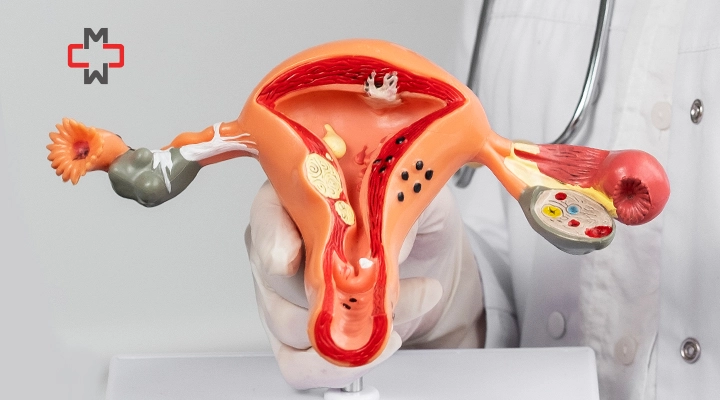Fast Facts About Ovarian Cysts
- What Are They?
Ovarian cysts are fluid-filled sacs that develop on or inside an ovary. - Common Sizes:
Cysts under 5 cm are typically harmless, while those over 10 cm may require surgery. - When to Worry:
Seek medical attention if you experience severe pelvic pain, sudden bloating, or dizziness. - Types of Cysts:
Functional (Follicular, Corpus Luteum), Dermoid, Endometriomas, Cystadenomas, and PCOS-related. - Causes:
Hormonal imbalances, endometriosis, pregnancy, severe infections, or genetics. - Symptoms:
Pain in the lower abdomen, bloating, menstrual irregularities, or frequent urination. - Complications:
Large cysts can cause ovarian torsion, rupture, or pressure on nearby organs. - Treatment Options:
Small cysts may resolve on their own; larger ones might need surgery or hormonal therapy.
Ever had a dull ache in your lower tummy and wondered if it’s serious? One of the causes of this pain can be an ovarian cyst. Ovarian cysts are common and often harmless but knowing when they are a problem is key to your health.
Let’s get into everything you need to know about ovarian cysts including types, causes and symptoms and answer the question “What size is a dangerous ovarian cyst”
What is an Ovarian Cyst?
An ovarian cyst is a fluid filled sac on or inside an ovary. Ovaries are part of the female reproductive system and produce eggs and hormones like estrogen and progesterone. Most ovarian cysts are benign (non cancerous) and will resolve on their own but some can cause complications like pain, bleeding or even fertility issues (learn more about ovarian cysts).
Types of Ovarian Cysts
Ovarian cysts come in many types:
Functional Cysts:
- Follicular Cysts: When the follicle (a sac that holds an egg) doesn’t rupture and release the egg and instead fills with fluid.
- Corpus Luteum Cysts: When the follicle releases the egg and seals itself and fills with fluid.
Dermoid Cysts:
- Contain hair, skin or teeth because they come from embryonic cells.
Endometriomas:
- When endometrial tissue (which lines the uterus) grows on the ovaries.
Cystadenomas:
- Grow from cells on the outer surface of the ovary and can contain watery or mucous fluid.
Polycystic Ovary Syndrome (PCOS):
Multiple small cysts due to hormonal imbalances affecting ovarian function (more on types).
What size is a dangerous ovarian cyst?
The size of an ovarian cyst can be an indicator of danger. While a normal ovarian cyst size (less than 5cm or 50mm) is usually benign and symptomless, larger cysts (over 5cm or 50mm) can be a problem. Cysts over 10cm (100mm) are a big concern and may need surgery.
Large cysts can cause:
- Ovarian Torsion: Twisted ovary cutting off its blood supply and causing severe pain.
- Rupture: Internal bleeding and severe pain.
- Compression of Surrounding Organs: Urinary and bowel issues (cysts over 10cm).
What causes cysts on ovaries?
Ovarian cysts can develop for many reasons:
- Hormonal Imbalances: Can affect ovulation and cause functional cysts.
- Endometriosis: Causes endometriomas.
- Pregnancy: Corpus luteum cysts often develop early in pregnancy.
- Severe Pelvic Infections: Can spread to the ovaries and cause cysts.
- Genetic Factors: Can influence conditions like PCOS (factors leading to ovarian cysts).
Symptoms of Ovarian Cysts
Most ovarian cysts are symptomless but larger or problematic cysts can cause:
- Pelvic Pain: Dull or sharp pain in the lower abdomen.
- Bloating and Fullness: Feeling of heaviness in the abdomen.
- Pain During Intercourse: During or after sex.
- Menstrual Irregularities: Abnormal bleeding or spotting.
- Frequent Urination: If a cyst presses on the bladder (symptoms to monitor).
How fast do ovarian cysts grow?
Ovarian cyst growth rate varies. Functional cysts grow slowly and may resolve on their own in a few cycles. Cysts related to endometriosis or dermoid cysts may grow steadily and need medical attention.
An ultrasound is used to monitor ovarian cyst growth and in some cases a blood test for CA-125 is done to rule out malignancy.
How are ovarian cysts treated?
Treatment for ovarian cysts depends on type, size and symptoms:
- Watchful Waiting: Monitor small, symptomless cysts with ultrasounds.
- Medications: Hormonal contraceptives to prevent new cysts from forming.
- Surgery: For large, persistent or symptomatic cysts.
Surgical options:
- Laparoscopy: Minimally invasive surgery to remove the cyst.
- Laparotomy: A more invasive procedure for larger cysts.
Surgery is recommended for cysts over 10cm or if malignancy is suspected. Recovery time: 2-3 weeks for laparoscopy and 4-6 weeks for laparotomy (more info).
When to see a doctor?
You should see a doctor if you have:
- Severe or sharp pelvic pain: Especially sudden.
- Fever or Vomiting: With abdominal pain.
- Faintness or Dizziness: Could be internal bleeding.
- Rapid Breathing: Or difficulty breathing.
- Unexplained Weight Loss: Or noticeable abdominal swelling (warning signs).
FAQs
At what size should an ovarian cyst be removed?
Ovarian cysts larger than 5 cm often require evaluation for removal, especially if symptomatic. Surgery is typically recommended for cysts exceeding 10 cm.
What size of ovarian cyst is cancer?
Size alone doesn’t determine malignancy, but larger cysts with irregular shapes or complex features may require further testing, such as a CA-125 blood test.
Will removing an ovarian cyst help me lose weight?
Weight loss varies. Large cyst removal can reduce bloating and abdominal size, leading to a slight decrease in weight.
-
About The Author
Dr. Syra Hanif M.D.Board Certified Primary Care Physician
Dr. Syra Hanif is a board-certified Primary Care Physician (PCP) dedicated to providing compassionate, patient-centered healthcare.
Read More







